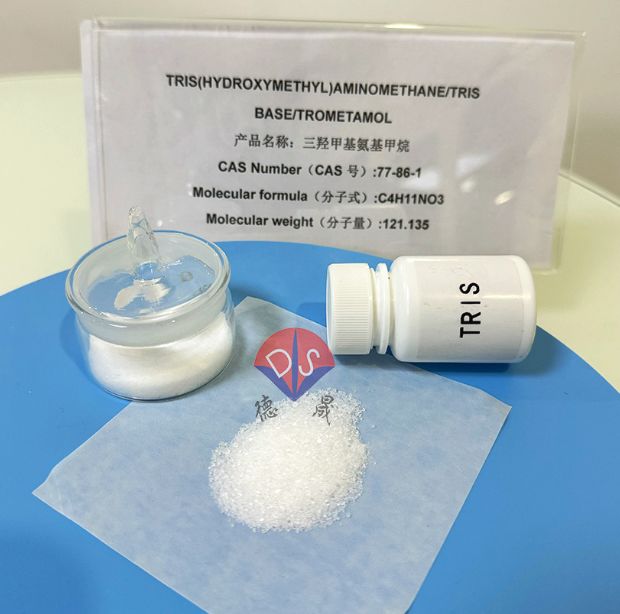TRIS detection strategy: acid-base titration HPLC、 Comparison of advantages and disadvantages of spectrophotometry
Release time:
2025-05-30
TRIS (Trimethylaminomethane) is a common and important buffering agent in biochemical experiments and production, widely used in the extraction and purification of nucleic acids and proteins, as well as in experimental processes such as PCR and electrophoresis. However, accurate detection of TRIS content is crucial for ensuring the reliability of experimental results and product quality. At present, there are various TRIS detection methods on the market, each with its own advantages and disadvantages. Let's delve into the pros and cons of these methods together.

TRIS base powder
Acid-base titration
Acid base titration is a detection method with a long history and relatively simple operation. Its principle is based on the alkalinity of TRIS, using a known concentration of acid standard solution for titration, determining the titration endpoint through a suitable indicator (such as phenolphthalein), and then calculating the TRIS content based on the volume of acid consumed. The advantages of this method are obvious. It does not require complex and expensive instruments and equipment, and can complete the detection with only common glassware and chemical reagents. The cost is low, and the operation process and principle are easy to understand, which is easy for some basic laboratory operators to handle.
However, acid-base titration also has significant drawbacks. The common problem with TRIS is poor selectivity, as it can only measure the total alkalinity in the solution and cannot distinguish it from other alkaline substances. If the sample contains other alkaline impurities that can react with acid, these impurities will also consume the acid standard solution, resulting in higher detection results that cannot accurately reflect the true content of TRIS. Therefore, acid-base titration method is suitable for rough detection scenarios with low precision requirements, relatively simple sample composition, and few impurities.
High performance liquid chromatography (HPLC)
High performance liquid chromatography plays an important role in the field of TRIS detection due to its powerful separation and detection capabilities. It can effectively separate TRIS from complex impurities in the sample by utilizing the difference in distribution coefficients between different substances in the stationary and mobile phases, and then perform quantitative analysis through high-sensitivity detectors such as ultraviolet detectors, fluorescence detectors, etc. The advantages of HPLC are very prominent, as it has very high separation efficiency and selectivity. It can not only accurately determine the content of TRIS, but also analyze multiple components simultaneously, and has particularly strong analytical capabilities for complex samples.
However, HPLC also has its limitations. Firstly, it requires a professional and expensive high-performance liquid chromatograph, which incurs high purchase and maintenance costs. Secondly, the pre-treatment requirements for samples are extremely strict, usually requiring complex steps such as extraction, purification, and concentration, which are relatively cumbersome and time-consuming.
Spectrophotometry
Spectrophotometry is a quantitative analysis method based on the absorption characteristics of substances towards specific wavelengths of light. In TRIS detection, a substance with a specific color is generated by reacting TRIS with a specific reagent, and then the absorbance of the colored substance at a specific wavelength is measured using a spectrophotometer. The content of TRIS is calculated based on the relationship between absorbance and concentration. This method is easy and fast to operate, does not require complex sample pretreatment processes, and requires relatively simple instruments and equipment. It is also relatively inexpensive and easy to popularize.
However, spectrophotometry also has significant shortcomings. Its sensitivity is relatively low, and its detection effect for low concentrations of TRIS is poor, making it difficult to meet some experimental and production requirements with high detection limits. Meanwhile, the selectivity of this method largely depends on the reagents and reaction conditions used. If other substances with similar optical properties are present in the sample, interference can easily occur, affecting the accuracy of the detection results.

Product packaging
As a professional supplier in the field of biological buffering agents, Desheng New Materials, with years of technological accumulation and innovation, provides high-quality TRIS products for researchers and production enterprises. The TRIS produced by Desheng New Materials has high purity, small batch differences, and stable performance, ensuring the reliability of testing results from the source. Not only that, Desheng New Materials also has a professional technical team that can provide customers with comprehensive technical support and solutions. Whether it is technical difficulties in experiments or quality control in the production process, timely and effective assistance can be provided.
Contact details
Contact number
Address: C8, Guanggu United Science and Technology City, Ezhou City, Hubei Province
Fax:0711-3704 589
Follow us



